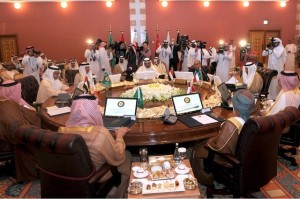by Giorgio Cafiero
“Revolution, revolution!”
“The people want the downfall of the regime!”
Fed up with a crumbling economy, state negligence, and widespread corruption, thousands of Lebanese have defiantly chanted these slogans this month amid difficult times. Although Lebanon’s ongoing nationwide protests, which have rocked Beirut, Tripoli, Tyre, and Baalbek, are not the first time that the country’s citizens have risen up in modern history, they represent the largest mass movement that the country has witnessed in almost 15 years.
In terms of the direction in which Lebanon is headed, there are more questions than answers. How will the Lebanese government ultimately deal with the demands of its outraged citizens on the street? How will the protesters respond to whatever the government does? It remains to be seen. What is clear is that the economic reforms promised by the leadership on October 21 have not brought an end to the protests, perhaps because the Lebanese public no longer trusts what the country’s political elites say. Many of the citizens who have joined these anti-government demonstrations have called for the wholesale resignation of the country’s 30-member Cabinet and for its replacement with a smaller, technocratic one.
In unveiling the reforms, Prime Minister Saad Hariri told the Lebanese people, “The decisions that we made today might not fulfill your goals but for sure it achieves what I have been seeking for two years… These decisions are not for exchange. I am not going to ask you to stop protesting and stop expressing your anger. This is a decision that you take.”
It appears that the reforms promised by Hariri are too little, too late. Meanwhile, a growing number of experts are increasingly fearful of Lebanon’s looming cash crisis.
You Say You Want a WhatsApp Revolution?
The final straw for many was apparently the government’s announcement on October 17 that its 2020 budget would include a new tax on WhatsApp calls. The country immediately responded, with many of its angry citizens taking to the streets to express their outrage, and the government quickly scrapped the tax plan. Nonetheless, once the protests got underway they quickly reached a scale that Lebanon has not seen since 2005, and are continuing amid what Lebanese newspapers have called a “WhatsApp revolution” and a “tax intifada.”
Citizens were also outraged by a September 30 New York Times report revealing that Hariri had paid USD 16 million to a South African bikini model whom he had met years earlier. That he spent so much money lavishly enraged many across Lebanon, particularly given that his company and media empire in Lebanon have not been paying their employees’ salaries amid the country’s economic struggles. People were also angered by the state’s inability to control a recent outbreak of forest fires, as its firefighting equipment had not been properly maintained.
Clearly, while the announced WhatsApp fee triggered these demonstrations, the causes of unrest and popular protest against the government are many and deep-rooted. Poverty, high youth unemployment, poor public services, dilapidated infrastructure, and a ruling elite that is unbound by the rule of law are not new issues in Lebanon. The current rage is about economic mismanagement, corruption, and criminal activities on the part of those among that elite who have enjoyed privileged positions since Lebanon gained her independence in 1943. One mid-aged Lebanese man explained, “The people were already at the edge barely holding on. The WhatsApp issue broke whatever they were still holding on to. Thank God, the people have awoken.”
A number of shocking statistics about conditions in Lebanon help explain the citizen outrage. Thirty-seven percent of those under the age of 35 are unemployed. According to the World Bank, more than one-quarter of the population lives below the poverty line. More than half of the population is not connected to official water supplies, while full electricity coverage is only enjoyed by a small percentage of the population. Although many ruling elites want to impose more austerity on the population to raise revenues, there is widespread anger and opposition to any ideas that place even more economic burdens on the backs of the poor.
Nepotism and corruption are rampant in Lebanon. Out of 180 countries, anti-corruption watchdog Transparency International ranked Lebanon 138 last year. The widening gap between the fortunate few and the vast majority of Lebanese has contributed significantly to the ongoing unrest. In Lebanon, there is great income and wealth inequality. The country’s bottom 50 percent receives only 10 percent of national income, while its wealthiest one percent takes in 25 percent of national income. In Lebanon, the billionaire class receives 20 percent of the national income—a greater share than in other countries where income and wealth inequality is also high, such as the U.S. and China, where the same figure is 10 and two percent, respectively.
Of course, many of Lebanon’s problems have been exacerbated by the influx of 1.5 million Syrian refugees who currently represent almost 25 percent of the national population—to say nothing about the Palestinian refugees who were already in the country and represent approximately 10 percent of the national population. With rapid capital flight, stagnant economic growth, and the world’s third highest debt-to-GDP ratio, Lebanon’s poor financial health has made life increasingly difficult for its citizens, particularly those at the lower end of the economic ladder.
Not About Religion or Sect
This wave of anti-government protests is significant because of the protestors’ diversity and the demonstrations’ geographic reach. Those on the streets are Lebanese citizens of all political and communal identities. What makes these protests particularly unique is that the demonstrators are blaming their own communities’ leaderships. It is difficult to exaggerate this significance of this reality given the extent to which the Lebanese people have been so often politically divided along sectarian lines throughout modern history.
Clearly, unlike the wave of protests that swept the region during the 2011 Arab Spring, in which the Lebanese demanded changes that fell short of revolution, the calls made by citizens this time around are revolutionary. Such revolutionary zeal stems from how much patience ordinary citizens have lost with politicians who constantly promise effective reforms but fail to deliver.
The Regional Context
Without question, the unrest in Lebanon is unique given the local history, political structure, and culture. Yet these protests must be understood within the context of active protest movements across the larger Arab world.
Many Algerians, Egyptians, Iraqis, Moroccans, and Sudanese have taken to the streets in 2019 due to factors that have much in common with the issues fueling anger in Lebanon. Such demonstrations are shattering myths, such as the one about the Arab Spring being “dead”. The idea that Arab populations are unwilling to take to the streets for fear of instability is proving to be increasingly out of touch with region’s realities.
The citizens of Lebanon and other Arab states are showing increased frustration with stagnant economic growth plus corruption and mismanagement on the part of their ruling elites. Put simply, they are not willing to take it any longer.
For the region’s counter-revolutionary forces—the governments of Saudi Arabia, the United Arab Emirates (UAE), Bahrain, Egypt, Libya’s House of Representatives (HoR), and Yemen’s UN-recognized administration—the Arab world should be increasingly authoritarian. These leaderships tend to believe that anti-government voices must be met with heavy-handed tactics rather than accommodation.
In the case of Lebanon, where so many citizens see a hopeless future without revolution, the state’s oppressive tactics for dealing with dissent are not proving effective. For Gulf monarchies that do not want to see masses of young people gathering in Arab cities to publicly demand fundamental political change, the situation in Lebanon seems unsettling and poses a delicate dilemma. A major concern for these states is that a successful revolution in Lebanon could set a dangerous precedent for the region and inspire young and similarly angry Arabs in other countries to follow the Lebanese lead.
Regardless of how influential Arab states and the rest of the international community—chiefly Washington and Paris—respond to Lebanon’s impasse, the ongoing street protests signal that the country is ready for a new era. The time has come for Lebanon to move beyond a political class that has proven incompetent and corrupt. No longer can sectarian narratives be used cynically in order to keep certain communities loyal and uncritically tolerant of their leaders, because members of all religious communities and sects have joined together to tell their leaders, “enough is enough.”





Lebanese seem to sense that their government – politicians, public servants, and social programs – have gone sour. They sense that corruption comes from the direction of public programs, expenditures, and laws, corrupted by the collusion of public managers, and the private sector that feed off public expenditures, tax policies, and established rules of game of governance. In short, what exists is the seedbed of “corruption.” When responding to market forces, and not a manipulative public sector, the private business sectors compete, and make their profit responding to the demands of an open market. Their success depends on their efficiency, productivity, and costs, not who your friends are in politics, or the bueacracy.
What is true for Lebanon, is likely true in any country.